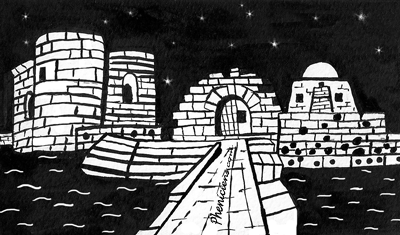
Sidon
Described as "the firstborn of Canaan" even later like the "mother of Canaan", the ancient city of Sidon (Saida today) enjoyed great fame in antiquity. The "Sidonian" term was confused with that of "Phoenician" in the Homeric and biblical tradition...
The Sidonian city is situated on a small promontory, facing a row of small islands along the coast delimited by two small rivers: to the north Nahr el-kamleh, and southerly Nahr el-Barghout. The oldest vestiges (a Chalcolithic implanting discovered at the site of Dakerman), date back to the middle of the fourth millennium. The habitat was composed of oval construction, non-squared gravel covered with a thick argillaceous plaster. The village was surrounded by a wall of more than two meters thick. Eight tombs were unearthed within the habitat area, with jars in which were human remains of adults.
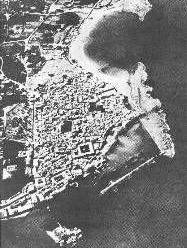
View of the city of Sidon
The impossibility of carrying out archaeological research and excavations in the urban area, has led researchers to work on the peripheries and the surroundings of the city. It is in the hinterland that were discovered tombs dating from the Bronze Age and Iron Age. The funerary material included Egyptian scarabs, bronze axes, cylinder seals Syrian style, Cypriot ceramics, jewelry ..., attesting to the relationships between the countries of the Eastern Mediterranean.
The city of Sidon, like all other Phoenician cities of the coast, was successively part of the territory of Egypt of Ramses II (-1275), then of the Assyrians (-701) with Sargon, then of the Babylonians (- 585) of Nebuchadnezzar, Cyrus of Persia (-539) and Alexander the Great (-333) finally under the Roman occupation (-64), passing through certain periods of autonomy or twinning with Tyre. It suffered throughout the centuries, the politics of conquerors, but was able to bring a touch of independence with its spirit of adventure and its ability to navigate over the seas.
The importance of Sidon was manifested by the fact that the name of the city, in cuneiform writing, was preceded by the classifier "Kur", which means "country", while Tyre, its southern neighbor, was described as "uru": "city". Sidon possessed a fleet well before Tyre, and its commercial supremacy provoked the admiration of the powers of the period(1).
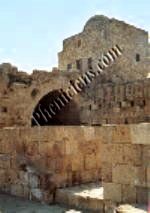
The sea fortress
The relationship between these two southern cities depended on the forces in place. Either they rallied under the control of a single king, or they tore apart by allying with the enemy, looking thereby a territorial recompense at the expense of the other city. During the Assyrian raids, Sidon was not really touched, it benefited from a heyday through a political-economic coalition with Tyre. For nearly a century and a half in the ninth and eighth centuries, the two cities have united under the rule of the same king. Then alternate favors by sovereign Assyrian, enlarged or reduced the territory, either at the expense or in favor of the other.
The Assyrians had nevertheless understood their interest by leaving these cities free to trade and establish trading posts in the Mediterranean, thus allowing the precious metals of the western Mediterranean to flock to the East. However, this autonomy was relative: permanent representatives of the Assyrian king controlled local respect in the interests of their master, so any attempt to revolt was immediately and rigorously repressed (Sidon revolted in 677 BC, and Tyre in 671 BC, and 663 BC).
This Assyrian presence represented a double-edged weapon. Faced with the political and military pressure, some people decided to look elsewhere for a less burdensome situation and hence settled in Western trade ports. But the needs of Assyria had also generated a new market, where Phoenician sailors could were selling their various merchandise, which they brought back from all the countries around the Mediterranean Sea.
After 638 BC, Assyria lost its influence, and the Levant regained some independence. Egypt, which experienced a period of renaissance under the Saite dynasty attempted to regain some influence, but its pretensions remained without a future. In -605, Nebuchadnezzar king of Babylon, enters the scene. His victory against the Egyptians at Carchemish opened the doors throughout the region. Like all these conquerors' predecessors, he attempted to ensure a complete dominance over the richness of the coast; namely of wood and boats, and on the trade. He then deported all the kings of the Phoenician cities to Babylon.
The city of Sidon regained some new energy with Cyrus, the Persian king, after the fall of Babylon and so took back its role as a maritime city. Its famous seamen, as well as other Phoenician seamen, placed their experience at the service of the new conquerors. Phoenician boats formed the flagship of the Persian fleet commanded by Darius and Xerxes in the assault of Greece. The kings of the Phoenician cities were admirals, each at the head of his city contingent. Herodotus mentions among them Tetramnestos from Sidon, Matten the Tyrian, and Merbalos from Arwad.
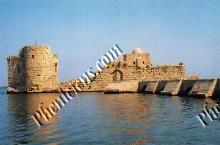
The sea fortress
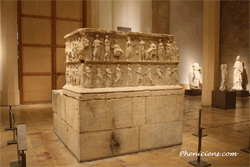
Echmoun Tribune, Beirut National Museum
Sidon, throughout the Persian period, kept a predominant position in the Phoenician world. From this period dates the construction of the temple of Echmoun, as well as major cemeteries. The inscription on the famous sarcophagus of the young king Echmounazor, noted that the Persian emperor, "the king of kings", granted to the king, many lands in exchange for support to his fleet. These arrangements between the local administration and Persian authority did not last long, several revolts broke out in the city but were ferociously reprimanded.
Although it has been the ally of the Persians during the Median wars, Sidon was spared by Alexander the Great, when he conquered the Phoenician coast in -332, but he exiled its king and appointed a new one in his place. Following the destruction by the Greeks of its rival Tyre, Sidon had once again regained its supremacy in relation to other Phoenician cities. In Roman times, the city was transformed into a republic managed by judges, governors and a senate. Its territory was expanded to Mount Hermon in the east.
| (1) |
Gras, Rouillard & Texidor, l'Univers Phénicien, Hachette Pluriel, 1995, P48 |
Retour texte |




